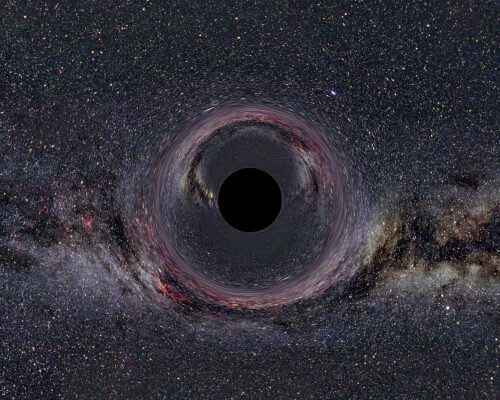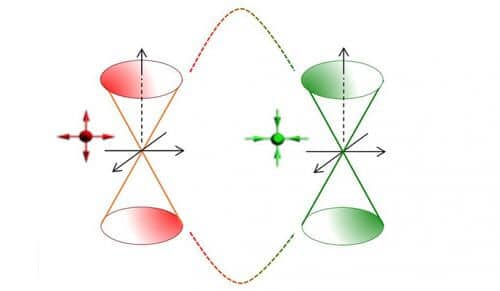In the research of Dr. Binghei Yan, new materials pave the way for new discoveries in physics

Dr Binghai Yan, who recently joined the condensed matter physics department at the Weizmann Institute, defines himself as a "theoretician engaged in experimental research". That is, he investigates the properties of new and intriguing materials using mathematics and simulations, and based on his findings, he makes suggestions for new experiments. For example, in the study thatRecently published in the journal Nature Dr. Yan and colleagues from Germany, Switzerland and the United States succeeded in proving a "gravitational anomaly", a basic concept that has been studied for many years. Their work was hailed as "a step towards understanding the mystery of black holes".
A gravitational anomaly has been predicted, under certain circumstances, within some of the most fundamental equations of physics, including the rotation of neutron stars and the early universe, but has never actually been observed. It was considered a very small effect, which can only be seen in the curvature of space-time near black holes or just after the big bang, or, at the very least, in a complex experiment at high energies. But the research team was able to document it by measuring thermoelectric conductivity in a piece of material known as "Weill's semimetal NbP" - a material recently discovered in Dr. Yan's research.
What is special about this material? It contains elementary particles called "Weyl fermions". In these particles, the spin - a property of quantum particles that is generally reminiscent of the spin of a football - is parallel or anti-parallel to the direction of motion. This is how the spin and motion are locked - a phenomenon known in physics as "chirality", and depending on their spin, Weyl fermions are in "left-handed configuration" or "right-handed configuration". It is the chirality that turns the Weyl fermions into ideal systems for detecting anomalies, phenomena that contradict the fundamental laws of quantum mechanics, which state that particles and spin numbers must be conserved.

As for a gravitational anomaly, it appears, for example, in quantum field theory, where a curved space-time can create an imbalance between particles in the right-hand configuration and particles in the left-hand configuration, something that will make it difficult to maintain equality between the two configurations. Dr. Johannes Guth, who conducted the experiment, and who is currently conducting post-doctoral research at the IBM research center in Zurich, applied a temperature drop and a magnetic field on Weyl's semi-metal in the laboratory. According to Dr. Yan, this created an analogous phenomenon of curved space-time, which allowed researchers to observe the effect of Weyl fermions on gravity. This research opens a door for further research in relation to quantum field phenomena that have not yet been detected.
Dr. Yan intends to continue researching the unique characteristics of topological materials, and even to conceive new materials. He believes that some of them may have interesting optical and magnetic properties. Furthermore, these materials may even have practical uses; For example, in the creation of data storage media, and even in the construction of a quantum computer
Weyl's semimetals belong to a relatively new group of materials known as topological materials, solid materials with exotic electronic properties. The origin of these materials is in the mathematical concept of topology, and discoveries were noted in the awarding of the Nobel Prize in Physics for 2016. Dr. Yan intends to continue researching the unique characteristics of these materials, and even to conceive new materials. He believes that some of them may have interesting optical and magnetic properties, thanks to which further experiments in the physics of strange particles and quantum behaviors will be possible. Furthermore, these materials may even have practical uses; For example, in creating new data storage media, and even in building a quantum computer.
At home in Israel

Although Dr. Yan has been at the Weizmann Institute of Science for only a few months, he feels, according to him, "at home". He was born in northern China, not far from Beijing, and received his doctorate from Tsinghua University. He continued his postdoctoral studies at the University of Bremen in Germany, at Stanford University in the United States, and then at the Max Planck Institute for Physical Chemistry of Solids in Germany. During this period he made connections with several physicists from the Weizmann Institute of Science, with whom he continues to work today. "I collaborate with researchers at the institute in the field of basic theory and in the field of measurements, and also with the group in Germany for the production of the materials. Together, we are a very nice team", he says. Together with Dr. Haim Beidenkopf, a senior experimental scientist at the institute, Dr. Jan "saw" Weyl fermions for the first time using a scanning tunneling microscope.
Dr. Yan is married to Juanhuan Wang, currently a research student in Prof. Dan Yakir's group from the Department of Earth and Planetary Sciences at the institute. The couple has two children, aged two and four, and Dr. Jan says that they particularly appreciate the quality of the kindergartens at the institute.
